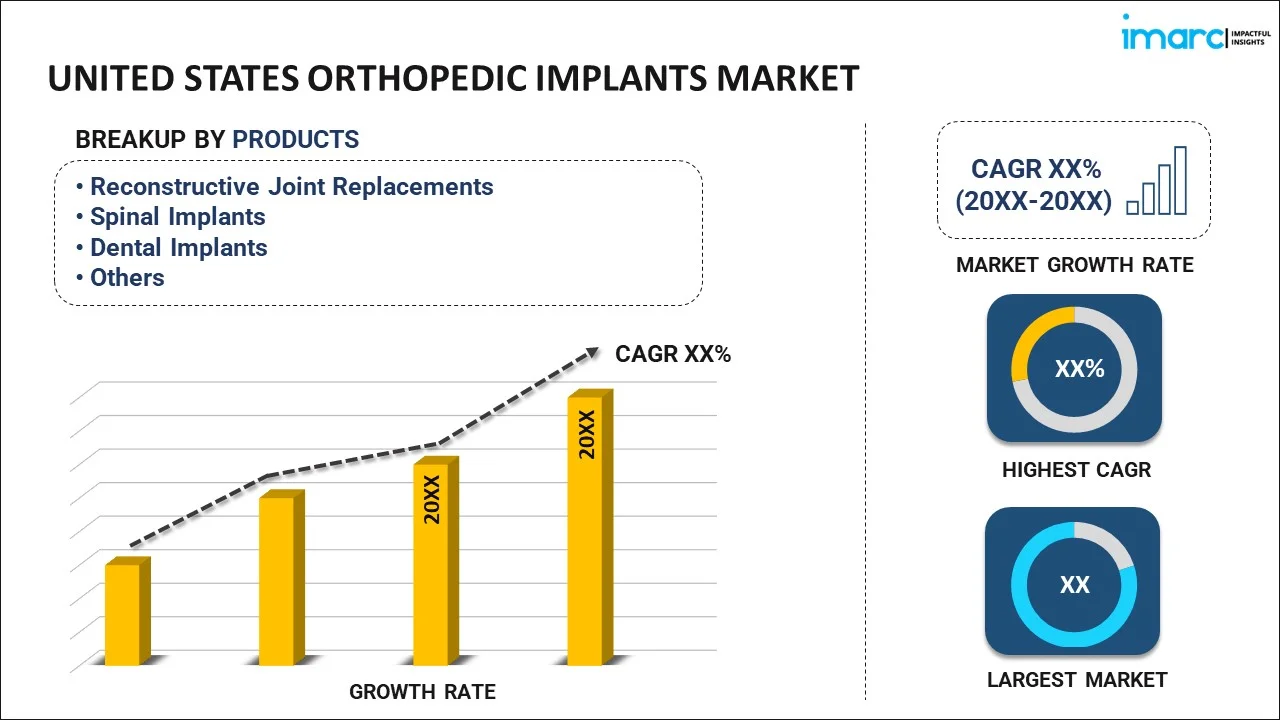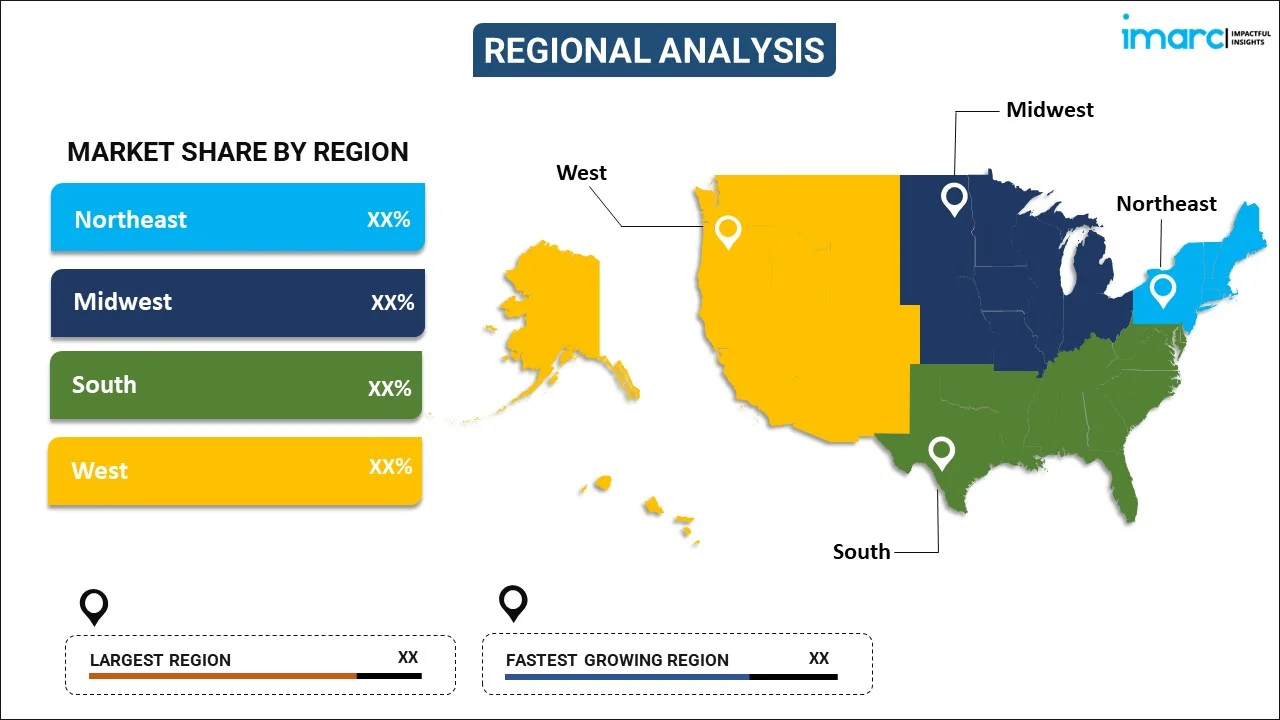
United States Orthopedic Implants Market Report by Product (Reconstructive Joint Replacements, Spinal Implants, Dental Implants, Trauma, Orthobiologics, and Others), Type (Knee, Hip, Wrist and Shoulder, Dental, Spine, Ankle, and Others), Biomaterial (Metallic Biomaterials, Ceramic Biomaterials, Polymers Biomaterials, and Others), End User (Hospitals, Orthopedic Clinic, Ambulatory Surgical Centers, and Others), and Region 2025-2033
Market Overview:
United States orthopedic implants market size reached USD 13,796.75 Million in 2024. Looking forward, IMARC Group expects the market to reach USD 21,129.67 Million by 2033, exhibiting a growth rate (CAGR) of 4.85% during 2025-2033. The increasing advances in orthopedic implant materials, design, and manufacturing technologies that have led to the development of more durable, efficient, and patient-friendly implants, are driving the market.
|
Report Attribute
|
Key Statistics
|
|---|---|
|
Base Year
|
2024
|
|
Forecast Years
|
2025-2033
|
|
Historical Years
|
2019-2024
|
|
Market Size in 2024
|
USD 13,796.75 Million |
|
Market Forecast in 2033
|
USD 21,129.67 Million |
| Market Growth Rate 2025-2033 | 4.85% |
Orthopedic implants play a pivotal role in modern medicine, revolutionizing the treatment of musculoskeletal disorders and injuries. These implants are specialized devices designed to replace or support damaged joints, bones, or other orthopedic structures. Common examples include artificial joints, plates, screws, and rods. Crafted from biocompatible materials like titanium and stainless steel, these implants integrate seamlessly with the body, promoting healing and restoring functionality. Orthopedic implant procedures, such as joint replacements, have become routine, offering relief to millions suffering from conditions like arthritis or fractures. Advancements in implant technology have led to enhanced durability, reduced wear and tear, and improved patient outcomes. Additionally, the development of minimally invasive techniques has minimized recovery times and postoperative discomfort. As the aging population grows, orthopedic implants continue to be instrumental in maintaining mobility and enhancing the quality of life for individuals. The ongoing research and innovation in this field promise further breakthroughs, ensuring a brighter future for orthopedic care.
United States Orthopedic Implants Market Trends:
The orthopedic implants market in the United States is witnessing robust growth, primarily propelled by an aging regional population and a surge in musculoskeletal disorders. As the elderly demographic expands, the incidence of conditions like osteoarthritis and fractures increases, fostering a heightened demand for orthopedic implants. Furthermore, technological advancements in implant design and materials contribute significantly to market expansion. Novel biomaterials and 3D printing technologies enhance implant durability and compatibility, driving innovation in the industry. Additionally, a growing awareness of the benefits of orthopedic interventions, coupled with an increasing emphasis on maintaining an active lifestyle, boosts the market. Rising healthcare expenditures, coupled with favorable reimbursement policies, also play a pivotal role in the market's upward trajectory. Collaborations between medical device companies and healthcare institutions further stimulate R&D, fostering a continuous cycle of innovation in the orthopedic implants sector. Overall, a convergence of demographic trends, technological advancements, and healthcare infrastructure development collectively propels the orthopedic implants market forward in the United States.
United States Orthopedic Implants Market Segmentation:
IMARC Group provides an analysis of the key trends in each segment of the market, along with forecasts at the country level for 2025-2033. Our report has categorized the market based on product, type, biomaterial, and end user.
Product Insights:

- Reconstructive Joint Replacements
- Knee Replacement Implants
- Hip Replacement Implants
- Extremities
- Spinal Implants
- Spinal Fusion Implants
- Vertebral Compression Fracture (VCF) Devices
- Motion Preservation Devices/Non-Fusion Devices
- Dental Implants
- Root Form Dental Implants
- Plate Form Dental Implants
- Trauma
- Orthobiologics
- Demineralized Bone Matrix (DBM)
- Allograft
- Bone Morphogenetic Protein (BMP)
- Viscosupplementation Products
- Synthetic Bone Substitutes
- Others
- Others
The report has provided a detailed breakup and analysis of the market based on the product. This includes reconstructive joint replacements (knee replacement implants, hip replacement implants, and extremities), spinal implants (spinal fusion implants, vertebral compression fracture (VCF) devices, and motion preservation devices/non-fusion devices), dental implants (Root Form Dental Implants and plate form dental implants), trauma, orthobiologics (demineralized bone matrix (DBM), allograft, bone morphogenetic protein (BMP), viscosupplementation products, synthetic bone substitutes, and others), and others.
Type Insights:
- Knee
- Hip
- Wrist and Shoulder
- Dental
- Spine
- Ankle
- Others
A detailed breakup and analysis of the market based on the type have also been provided in the report. This includes knee, hip, wrist and shoulder, dental, spine, ankle, and others.
Biomaterial Insights:
- Metallic Biomaterials
- Stainless Steel
- Titanium Alloy
- Cobalt Alloy
- Others
- Ceramic Biomaterials
- Polymers Biomaterials
- Others
The report has provided a detailed breakup and analysis of the market based on the biomaterial. This includes metallic biomaterials (stainless steel, titanium alloy, cobalt alloy, and others), ceramic biomaterials, polymers biomaterials, and others.
End User Insights:
- Hospitals
- Orthopedic Clinic
- Ambulatory Surgical Centers
- Others
A detailed breakup and analysis of the market based on the end user have also been provided in the report. This includes hospitals, orthopedic clinic, ambulatory surgical centers, and others.
Regional Insights:

- Northeast
- Midwest
- South
- West
The report has also provided a comprehensive analysis of all the major regional markets, which include Northeast, Midwest, South, and West.
Competitive Landscape:
The market research report has also provided a comprehensive analysis of the competitive landscape. Competitive analysis such as market structure, key player positioning, top winning strategies, competitive dashboard, and company evaluation quadrant has been covered in the report. Also, detailed profiles of all major companies have been provided.
United States Orthopedic Implants Market Report Coverage:
| Report Features | Details |
|---|---|
| Base Year of the Analysis | 2024 |
| Historical Period | 2019-2024 |
| Forecast Period | 2025-2033 |
| Units | Million USD |
| Scope of the Report | Exploration of Historical and Forecast Trends, Industry Catalysts and Challenges, Segment-Wise Historical and Predictive Market Assessment:
|
| Products Covered |
|
| Types Covered | Knee, Hip, Wrist and Shoulder, Dental, Spine, Ankle, Others |
| Biomaterials Covered |
|
| End Users Covered | Hospitals, Orthopedic Clinic, Ambulatory Surgical Centers, Others |
| Regions Covered | Northeast, Midwest, South, West |
| Customization Scope | 10% Free Customization |
| Post-Sale Analyst Support | 10-12 Weeks |
| Delivery Format | PDF and Excel through Email (We can also provide the editable version of the report in PPT/Word format on special request) |
Key Benefits for Stakeholders:
- IMARC’s industry report offers a comprehensive quantitative analysis of various market segments, historical and current market trends, market forecasts, and dynamics of the United States orthopedic implants market from 2019-2033.
- The research report provides the latest information on the market drivers, challenges, and opportunities in the United States orthopedic implants market.
- Porter's five forces analysis assist stakeholders in assessing the impact of new entrants, competitive rivalry, supplier power, buyer power, and the threat of substitution. It helps stakeholders to analyze the level of competition within the United States orthopedic implants industry and its attractiveness.
- Competitive landscape allows stakeholders to understand their competitive environment and provides an insight into the current positions of key players in the market.
Key Questions Answered in This Report
The orthopedic implants market in the United States was valued at USD 13,796.75 Million in 2024.
The United States orthopedic implants market is projected to exhibit a CAGR of 4.85% during 2025-2033, reaching a value of USD 21,129.67 Million by 2033.
The United States orthopedic implants market is driven by the rising prevalence of bone and joint disorders, increasing demand for minimally invasive surgical procedures, and advancements in implant materials and design. An aging population, growing sports-related injuries, and higher healthcare expenditure further accelerate the market’s growth trajectory.
Need more help?
- Speak to our experienced analysts for insights on the current market scenarios.
- Include additional segments and countries to customize the report as per your requirement.
- Gain an unparalleled competitive advantage in your domain by understanding how to utilize the report and positively impacting your operations and revenue.
- For further assistance, please connect with our analysts.
 Request Customization
Request Customization
 Speak to an Analyst
Speak to an Analyst
 Request Brochure
Request Brochure
 Inquire Before Buying
Inquire Before Buying




.webp)




.webp)












